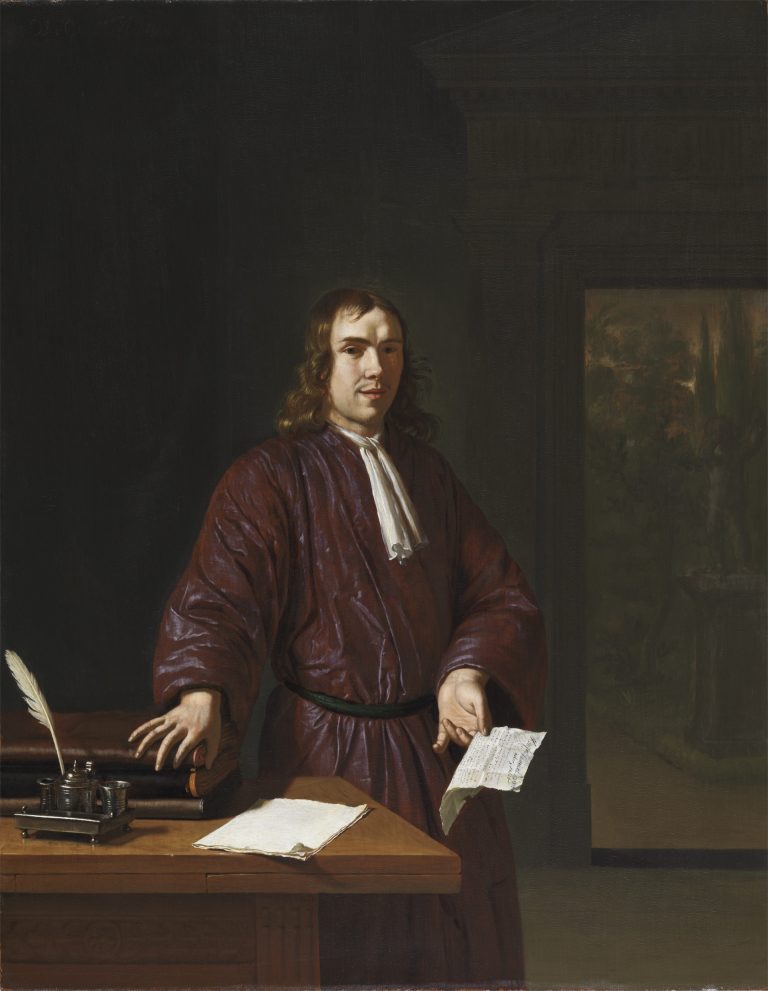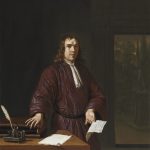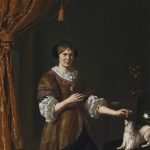These two paintings, dated 1683, are outstanding examples of the early work of the promising young artist Willem van Mieris, who painted these portraits in the very year he joined the Leiden Guild of Saint Luke.1 These portraits must have been one of the earliest commissions that he received as an independent painter. He painted another pair of portraits one year later that show a comparable approach, not only in the strong chiaroscuro effects and brownish tonalities, but also in the sitters’ fashionable appearance ((fig 1) and (fig 2)).2
The male sitter, Samuel van Acker, wears a luminous brown Japanese gown and stands in an interior with a pedimented door in the background. Through the door can be seen a garden with a statue of cupid. Holding a letter in his left hand, he rests his right hand on three bolts of fabric lying on the wooden table. His female counterpart also poses in an interior with a table and an open doorway, partially obscured by a curtain, in the background. Handsomely attired in a decorative black lace cap and a brown satin dress, she holds a rose in one hand and with the other feeds a small white dog standing on a chair beside her. On the table behind her is additional canine sustenance, together with a vase of flowers. In both paintings, bright light falling from the upper left illuminates the sitters and casts a deep shadow on the right side of their faces. The artist’s virtuosity in minutely rendering different kinds of materials and textures is evident in the shimmering highlights on the sitters’ clothing, as well as in the specular reflections glancing off the silver writing set beside Samuel van Acker.
The identification of the male is known from the letter he holds, which is addressed to: “Monsr Samuel van Acker” (fig 3). Van Acker was born in Leiden in 1658 as the eighth child of carpenter Jan van Acker and Adriaentje Samuels de Haen.3 In 1679 he married Maria le Maistre, daughter of greinwercker Pieter le Maistre and Maria Catoir. Samuel was at that time also a greinwercker, which means that he was manufacturing grein, a very delicate fabric, partly silk, used for ribbons and stockings.4 His profession is clearly indicated by the textile bolts on the table. Maria le Maistre died after giving birth to ten children, whereupon Samuel married Johanna de Hoest in 1697.
Considering that the two portraits were already described as pendants in several records in the nineteenth century, the female portrait probably depicts Maria le Maistre. In those days a young, wealthy couple would often commission an artist to paint their likeness to celebrate their marriage, and such huwelijksportretten (“marriage portraits”) were considered status symbols.5 Although the portraits are dated 1683, four years after the couple’s wedding, their marriage could have been the reason for the commission. The rose that the woman holds traditionally alluded to love, and might correspond to the garden statue of cupid in Samuel’s portrait.
The character of the woman’s pose, however, leaves some question as to her identity. In contrast to traditional companion pieces, in which couples face each other, the woman in this pendant pair does not turn toward her companion.6 The hanging curtain at the left further isolates her from him. Although it is rather difficult to imagine a young couple commissioning Van Mieris to portray them in such an unconventional way, the paintings’ identical dimensions, the matching scale of the sitters, the harmonious color scheme, and the complementary chiaroscuro effects relate the two pictures to each other extremely well. If the sitter is Maria, then there must have been a specific reason that Van Mieris depicted her in this unusual manner.
An alternative explanation is that the female sitter was another, perhaps unmarried, member of the Van Acker family. It could be that these two works originally belonged to a larger suite of family portraits and that they came to be joined as pendants only through the accident of history.7 In fact, it is likely that Van Mieris also made portraits of other members of the Van Acker family. According to his probate inventory, Samuel’s son owned a pair of portraits that Frans van Mieris the Elder (1635–81) had painted of his grandparents, Jan van Acker and Adriaentje Samuels de Haen. This pendant pair was appraised at the enormous amount of 500 guilders.8 The personal connection that Jan van Acker had with Frans van Mieris the Elder probably induced his son, Samuel, to turn to the fledgling artist Willem van Mieris to paint his portrait and other members of his family. Whatever the identity of the female sitter, these splendid portraits bear witness to the younger Van Mieris’s artistic talent and social connections, both of which he would develop further throughout the course of his career.


